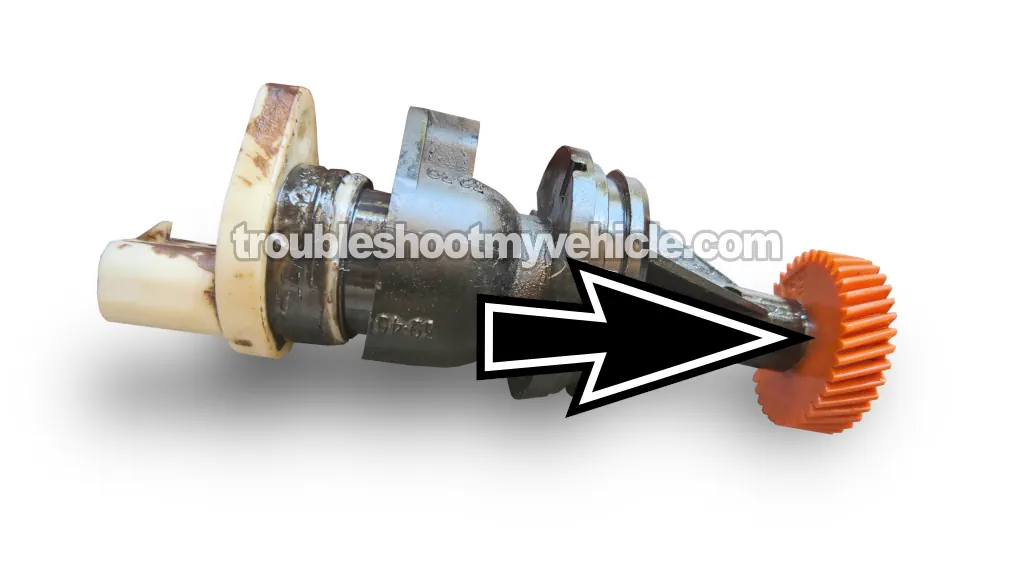TEST 3: Making Sure The VSS Sensor Is Getting Power

In this test, we're gonna make sure the vehicle speed sensor is receiving the 5 Volt supply it needs to operate.
If the 5 Volt supply is missing, the sensor can't function —and that alone would cause a P0500 trouble code.
This 5V reference voltage is provided by the PCM through the orange (ORG) wire of the 3-wire VSS sensor connector.
To check this, we'll unplug the sensor and measure the voltage directly at the 5V supply terminal in the connector.
These are the test steps:
- 1
Turn the key to the ON position but don't start the engine.
This will power up the PCM and activate the 5V supply circuit. - 2
Unplug the vehicle speed sensor from its 3-wire connector.
- 3
Set your multimeter to Volts DC mode.
- 4
Ground the black multimeter test lead to a clean metal surface on the chassis or engine block.
NOTE: The metal surface should be paint and rust free. - 5
Use the red multimeter test lead to probe the front of the orange wire terminal.
- 6
You should see 4.5 to 5 Volts if the supply circuit is intact and the PCM is sending power to the VSS sensor.
Let's interpret your test result:
CASE 1: 4.5 to 5 Volts are present at the orange wire. Great —the VSS sensor is receiving power.
Next, we'll make sure the sensor also has a good Ground. Go to: TEST 4: Making Sure The VSS Sensor Is Getting Ground.
CASE 2: No 4.5 to 5 Volts present at the orange wire. This usually indicates an open in the 5V supply circuit between the PCM and the sensor.
The most likely cause of this missing voltage is an open-circuit problem in the ORG wire between the VSS sensor connector and the PCM.
Diagnosing this type of issue is beyond the scope of this tutorial, but your next step is to find the cause and repair it.
TEST 4: Making Sure The VSS Sensor Is Getting Ground

In this final test, we're gonna make sure the vehicle speed sensor is receiving a good Ground. Without a Ground connection, the sensor can't generate its ON/OFF signal.
The Ground for the VSS sensor is supplied by the PCM itself, through the black with light blue stripe (BLK/LT BLU) wire at the 3-wire connector.
We'll use a multimeter to test for Ground safely —by checking for voltage across the Ground terminal and the 5 Volt supply terminal of the 3-wire connector.
IMPORTANT: This Ground is provided internally by the PCM. Never connect this circuit directly to battery 12 Volts, or you risk damaging the PCM. The multimeter test described below is safe and will not damage anything.
Let's begin:
- 1
Unplug the vehicle speed sensor from its 3-wire connector.
- 2
Turn the ignition key to the ON position, but don't start the engine.
This powers up the PCM and energizes the sensor circuits. - 3
Set your multimeter to Volts DC mode.
- 4
Touch the red multimeter lead to the female terminal of the connector that corresponds to the ORG wire (sensor 5V supply wire).
- 5
Touch the black multimeter lead to the female terminal that connects to the BLK/LT BLU wire (sensor Ground).
- 6
You should see a reading of around 4.5 to 5 Volts DC, confirming that the Ground wire is intact and the PCM is providing a good Ground path.
Let's figure out what your results mean:
CASE 1: Multimeter reads between 4.5 and 5 Volts. Perfect —this tells us that the PCM is supplying a proper Ground to the VSS sensor via the BLK/LT BLU wire.
Now, for our last test, go to: TEST 5: Inspecting The Plastic Speedometer Pinion Gear.
CASE 2: No voltage is detected. This means the PCM Ground is missing —most likely due to a break or open-circuit in the BLK/LT BLU wire between the PCM and the sensor connector.
Diagnosing this type of issue is beyond the scope of this tutorial, but your next step is to find the cause and repair it.
TEST 5: Inspecting The Plastic Speedometer Pinion Gear

The speedometer pinion gear, located under the Speedometer Drive Gear (SDG) Housing, is made out of plastic.
Over time, it's common for this gear to wear down or even strip completely —which can result in a dead speedometer and trigger the P0500 DTC.
For our last test, we'll remove the Vehicle Speed Sensor (VSS) and SDG Housing from the transmission or transfer case and inspect the gear.
NOTE: The SDG Housing and transmission case are aligned using index marks —one on the transmission or transfer case, and the other on the SDG Housing. If, for any reason, these index marks are lost or unclear, don't worry —you can follow the tutorial below to correctly reinstall the housing and sensor:
OK, let's get going:
- 1
Spray the VSS and SDG Housing area with brake cleaner to remove the years of grime and debris that has collected around it.
NOTE: Use safety glasses, and make sure no open flames are present. - 2
Allow the VSS/SDG Housing to dry completely.
- 3
Use an oil-based marker to make reference marks on both the housing and the transmission case or transfer case.
This step ensures you can reinstall the assembly in its original indexed position without guesswork. - 4
Remove the bolt and clamp securing the SDG Housing, then carefully pull the assembly out of the transmission or transfer case.
- 5
Inspect the plastic pinion gear for worn or broken teeth.
Look for damage such as rounded edges, chips, or missing sections of teeth.
NOTE: The number of teeth is usually embossed on the gear itself.
Let's interpret your test result:
CASE 1: The pinion gear is OK. Great —this is exactly what we want to see.
The VSS sensor is faulty and needs to be replaced if all the following have been confirmed:
- TEST 1: No vehicle speed data appears on the scan tool during the road test.
- TEST 2: No ON/OFF signal detected at the WHT/ORG wire of the sensor's 3-wire connector.
- TEST 3: The sensor is receiving 5 Volts.
- TEST 4: The sensor is receiving a good Ground.
- The plastic pinion gear is in good shape —not worn or broken (this test section).
Take a look at this section:
CASE 2: The pinion gear is worn or damaged. If the gear is worn out or stripped, you've found the cause of the P0500 trouble code. Replace the speedometer pinion gear.
When replacing it, make sure to use a new plastic gear with the exact same tooth count as the original. This is critical for the speedometer to display the correct vehicle speed.
Once replaced, reinstall the SDG Housing and VSS sensor, making sure to realign them using your marks —or follow the indexing guide if the marks were lost:
A More Controlled Way To Spin The Wheels For The VSS Signal Test
If you've ever tried to spin the rear wheels slowly with the truck in Drive, engine running, and the rear end up on jack stands —you already know it's easier said than done.
I've been there myself, and getting the wheels to rotate slowly enough to catch the ON/OFF voltage pulses from the vehicle speed sensor can be tricky.
One workaround that's worked well for me is this:
- Turn the key to the ON position (but don't start the engine).
- This powers up the VSS sensor.
- Position your multimeter somewhere visible from the rear of the vehicle (after tapping into the VSS signal wire).
- Now, with your helper turning one wheel and you turning the other (in the same direction), you can make sure the driveshaft actually spins —because without driveshaft rotation, the sensor won't produce its ON/OFF signal.
- Turning just one wheel may not be enough (to get the drive shaft rotating).
And just to be clear: the sensor isn't directly triggered by the driveshaft —but seeing the driveshaft spin tells you that the output shaft inside the transmission (which actually rotates the sensor's plastic pinion gear) is rotating.
This method takes a little coordination, but it gives you the control you need to see the signal clearly —especially when you're troubleshooting a stubborn P0500 code.
I've had to do this test myself, and I hope sharing this method saves you some time and frustration.
VSS Signal Reaches The PCM —But The Speedometer Doesn't Work
If your scan tool shows that the PCM is receiving the correct vehicle speed —but the speedometer on the instrument cluster stays at zero— then the Vehicle Speed Sensor (VSS) itself is doing its job.
Here's what's important to understand:The VSS outputs a signal on the white with orange stripe (WHT/ORG) wire. That wire splits internally —one branch goes to pin 27 of the WHITE PCM connector, and the other goes directly to the instrument cluster to operate the speedometer.
So, if your scan tool confirms the VSS signal is present (by checking the VEHICLE SPEED PID), yet the speedometer remains dead, it usually points to a failure inside the instrument cluster itself —specifically the speedometer circuitry.
To double-check, you can remove the instrument cluster and back-probe the WHT/ORG wire at the instrument cluster connector while manually spinning the rear wheels. If the signal pulses are present (as confirmed with your multimeter), your speedometer is bad.
Updated VSS Sensor Connector And Why Soldering Is Critical
By now, there's a good chance your Dodge Ram pickup already has the updated vehicle speed sensor and connector —they've been around for years. But in the rare case that it still has the original VSS and connector, know this:
When you purchase a new VSS sensor, it'll only be available in the updated style —and it comes with a new connector pigtail that must be spliced into the existing harness.
IMPORTANT: Avoid using crimp-style connectors (commonly called butt connectors) to install the new VSS pigtail. These can loosen over time due to heat, vibration, or corrosion —and they're a common cause of intermittent VSS failures that are frustrating to diagnose.
The correct and permanent fix is to solder the new connector in place and then seal the connections with high-quality heat shrink tubing. This ensures a solid electrical connection that won't fail on you later down the road.
It's a bit more work up front, but it saves you the headache of chasing down intermittent wiring issues later —especially with a sensor that's mounted underneath your pickup and constantly exposed to the elements.
More 5.2L, 5.9L V8 Dodge Ram Pickup Tutorials
I've written several more tutorials for the V8 Dodge Ram pickups that may be of interest to you that you can find in this index:
Here's a sample of the tutorials you'll find in the index:
- How To Test The Fuel Pump (1992-2003 5.2L, 5.9L V8 Dodge Ram Pickup).
- How To Test The MAP Sensor -P0107, P0108 (1997-2003 5.2L, 5.9L V8 Dodge Ram Pickup).
- How To Test Engine Compression (1989-2003 5.2L, 5.9L V8 Dodge Ram Pickup).
- Troubleshooting A Blown Head Gasket (1989-2003 5.2L, 5.9L V8 Dodge Ram Pickup).

If this info saved the day, buy me a beer!

